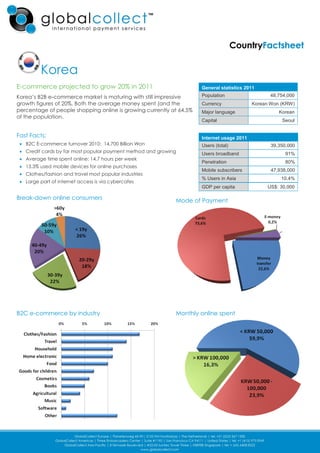
Globalcollect Korea Country Factsheet
- 1. Korea E-commerce projected to grow 20% in 2011 General statistics 2011 Korea’s B2B e-commerce market is maturing with still impressive Population 48,754,000 growth figures of 20%. Both the average money spent (and the Currency Korean Won (KRW) percentage of people shopping online is growing currently at 64.5% Major language Korean of the population. Capital Seoul Fast Facts: Internet usage 2011 B2C E-commerce turnover 2010: 14,700 Billion Won Users (total) 39,350,000 Credit cards by far most popular payment method and growing Users broadband 91% Average time spent online: 14.7 hours per week Penetration 80% 13.3% used mobile devices for online purchases Mobile subscribers 47,938,000 Clothes/fashion and travel most popular industries % Users in Asia 10.4% Large part of internet access is via cybercafes GDP per capita US$: 30,000 Break-down online consumers Mode of Payment B2C e-commerce by industry Monthly online spent
- 2. Success E-banking E-banking was introduced to South Korea in 1999. By the start of 2003, about a third of the country’s population used internet banking, second only to Sweden. People in their 30s made up the highest ercentage of internet banking customers, with 38.9%, followed by those in their 20s with 31.6% and those in their 40s with 19.4%. Males represented a slight majority of internet banking customers at 54.7%. According to the NIDA 2008 internet survey, 40% of all internet users over 12 years old were using internet banking services. By age, those in the 20s and 30s bracket show relatively higher rates with 57.2% and 56.3% respectively. The monthly average for internet banking was 4.8 times per month. By 2010, 42.3% of internet users aged 12 and above had used internet banking in the past year. In the last month it had been used by 31.6% and 11.6% in the last week. By age, those in the 20s and 30s bracket show relatively higher rates with 61.1% and 59.4% respectively. The monthly average for internet banking was 4.9 times per month. Most internet banking users, 96.2% used a computer while 9.2% used a mobile phone. The success of LG Telecom’s mobile phone banking (m-banking) service named Bank On, led to LG Telecom partnerships with other banks and spurred the other mobile operators to engage more in m-banking. Payment preferences Through credit card is the preferred payment, followed by real-time bank transfer the usage of mobile devices to make online purchases shows strong growth. Local entity requirement In order to accept local payment methods a local entity is required. Payment product spotlight GlobalCollect’s Portfolio in Korea International cards GlobalCollect supports MasterCard, Visa Bank transfer GlobalCollect supports Local bank transfers eWallet GlobalCollect supports PayPal Local Cards Local cards support is being developed by GlobalCollect Real-time bank transfer Realt-ime bank transfer is being developed by GlobalCollect the future’s list of GlobalCollect Mobile The support for mobile is on the future’s list of GlobalCollect Sources KCC Data ||March 2011 Comscore || 2011 Buddecom || 2011 http://www.kostat.go.kr/ || November 2011 Internet WorldStats || September 2011 NIDA Survey || 2008 V3.0
